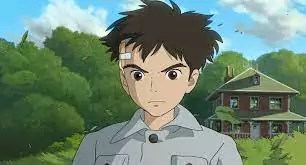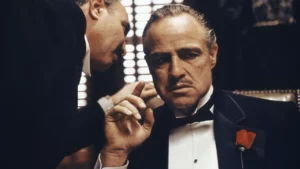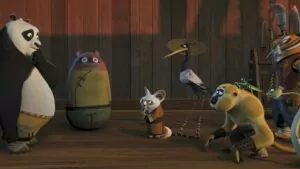Introduction:
The Boy and the Heron marks Hayo Miyazaki’s reported final film, a captivating journey blending the living and the dead. Mahito, a young boy, embarks on an epic adventure guided by a gray Heron. The film explores themes of loss, self-discovery, and the mysteries of an otherworldly realm.

Miyazaki’s Legacy
Hayao Miyazaki, the revered maestro of animation, has left an indelible mark on global cinema through decades of storytelling brilliance. Born on January 5, 1941, in Tokyo, Japan, Miyazaki’s career at Studio Ghibli has produced timeless classics that transcend cultural boundaries. From the enchanting flights of “Howl’s Moving Castle” to the mesmerizing realms of “Spirited Away,” his films seamlessly blend fantasy with profound themes. As a visionary director, Miyazaki’s farewell, “The Boy and the Heron,” invites audiences into a captivating world, serving as a poignant punctuation to his unparalleled career
Unexpected Complexity:
The Boy and the Heron unfolds as a journey that defies expectations and challenges the notion of a conventional animated adventure. What starts as a seemingly straightforward tale takes an unexpected turn, inviting viewers into a world of complexity and depth. The narrative, far from adhering to a linear structure, meanders through layers of storytelling, revealing nuances and intricacies that demand the audience’s attention and contemplation.
The film’s unexpected complexity is Hayao Miyazaki’s mastery in crafting narratives that transcend the boundaries of traditional animated storytelling. As we navigate the twists and turns alongside the protagonist Mahito, we find ourselves immersed in a story that not only entertains but also prompts reflection on the complexities of life, identity, and the delicate balance between the living and the dead.
Miyazaki’s Personal Touch:
Hayao Miyazaki, known for infusing his works with personal elements, takes this tendency to new heights in “The Boy and the Heron.” The film serves as a canvas upon which Miyazaki paints his emotions, experiences, and reflections. The protagonist’s journey, mirroring Miyazaki’s own life and struggles, becomes a poignant exploration of grief, loss, and the expectations placed upon an artist of Miyazaki’s stature.
In this deeply personal narrative, Miyazaki’s connection to his work transcends the screen. Viewers, aware of the filmmaker’s history and life events, may find themselves unravelling the layers of the film with a newfound appreciation for the vulnerability and authenticity that Miyazaki injects into every frame. The Boy and the Heron emerges not just as an animated feature but as an intimate expression of the artist’s soul.
Dreamlike Imagery and Allegory:
The dreamlike quality of The Boy and the Heron adds a layer of mystique to the storytelling, reminiscent of Miyazaki’s earlier work, “Angel’s Egg.” The film’s visual aesthetics, marked by surreal and ethereal landscapes, contribute to the creation of an otherworldly realm that blurs the lines between reality and fantasy. Within this dreamscape, Miyazaki invites viewers to delve into allegorical interpretations, fostering a connection between the fantastical elements on screen and the artist’s own introspections.
Mahito’s journey, seemingly disjointed and dream-inspired, becomes a canvas for allegory. Viewers are encouraged to peel back the layers and draw parallels between the film’s symbolic representations and Miyazaki’s own life journey. The dreamlike imagery, far from being mere visual spectacle, serves as a vessel for profound contemplation, allowing the audience to engage with the narrative on both a conscious and subconscious level.
Challenging Narrative and Confusing Elements:
The Boy and the Heron presents a narrative that refuses to adhere to conventional storytelling norms. As Mahito ventures into a world that blurs the boundaries between the living and the dead, the film challenges viewers to embrace ambiguity and navigate through a storyline that unfolds in a non-linear fashion. The creatures and events in this mystical realm, initially perplexing, invite the audience to surrender to the dreamlike quality of the narrative.
The film’s intentional ambiguity and occasional confusion serve as narrative devices rather than shortcomings. Miyazaki, known for pushing the boundaries of animated storytelling, invites viewers to embrace the unfamiliar, much like Mahito’s own journey. As certain elements float upwards and transform into living beings, the film becomes a visual and thematic exploration of the interconnectedness between different dimensions, challenging viewers to grapple with the unfamiliar and find meaning in the enigmatic.
Animation as a Reflection of Miyazaki’s Legacy:
The Boy and the Heron not only captivates with its narrative but also serves as a testament to the enduring beauty of hand-drawn animation. In an era dominated by computer-generated imagery, Miyazaki’s commitment to the traditional craft is a nostalgic nod to the golden age of animation. The film’s breathtaking hand-drawn sequences, particularly the visually arresting moment involving Mahito and a fish, stand out as a reminder of the artistry that can be achieved through meticulous craftsmanship.
The animation becomes a reflection of Miyazaki’s legacy, mirroring his dedication to a form of storytelling that transcends technological trends. The film’s success at the box office, coupled with its critical acclaim, raises the possibility of a renewed appreciation for hand-drawn animation, inspiring hope for a resurgence of the art form in an industry increasingly dominated by CGI.
Autobiographical Threads:
While The Boy and the Heron draws inspiration from the book “How Do You Live,” gifted to Mahito in the movie, Miyazaki weaves his own autobiographical threads into the fabric of the film. The narrative becomes a tapestry of Miyazaki’s life experiences, not just limited to the loss of his mother but extending to the broader themes of family, career, and artistic legacy. Mahito’s journey, though loosely inspired by external sources, becomes a deeply personal exploration for Miyazaki.
Viewers familiar with Miyazaki’s life may recognize the autobiographical elements embedded in the narrative. From his love for aviation to his reflections on Studio Ghibli’s legacy, the film becomes a poignant reflection on the artist’s journey. The autobiographical threads, delicately intertwined with the broader narrative, invite viewers to decipher the layers of meaning and connect with the film on a more intimate level.
Audience Reception and Long-Term Impact:
The Boy and the Heron emerges as a film that transcends immediate audience expectations. While not necessarily an easy watch, the film’s complexity, mature themes, and challenging narrative contribute to its long-term impact. The juxtaposition of critical acclaim and audience reception prompts contemplation on the appetite for more intellectually demanding animated features.
Miyazaki’s reputation as a master storyteller, coupled with the success of The Boy and the Heron at the box office, suggests an audience hunger for animated films that go beyond surface-level entertainment. The film’s refusal to provide easy answers positions it as a work of art that invites discussion, analysis, and a lasting imprint on the cinematic landscape. As viewers continue to engage with and dissect the film, its significance is likely to endure, solidifying its place in the pantheon of Miyazaki’s influential works.
The Movie Culture Synopsis:
In conclusion, The Boy and the Heron transcends the conventional expectations associated with animated films. While its complexity may deter some, the stunning animation, emotional depth, and Miyazaki’s personal touch make it a memorable cinematic experience. The film’s impact on the animation industry, coupled with its potential for enduring discussions, solidify its place in Miyazaki’s acclaimed portfolio.



